Deck 21: Substitution Reactions of Carbonyl Compounds at the a Carbon
Question
Question
Question
Question
Question
Question
Question
Question
Question
Question
Question
Question
Question
Question
Question
Question
Question
Question
Question
Question
Question
Question
Question
Question
Question
Question
Question
Question
Question
Question
Question
Question
Question
Question
Question
Question
Question
Question
Question
Question
Question
Question
Question
Question
Question
Question
Question

Unlock Deck
Sign up to unlock the cards in this deck!
Unlock Deck
Unlock Deck
1/47
Play
Full screen (f)
Deck 21: Substitution Reactions of Carbonyl Compounds at the a Carbon
1
Which of the following is the intermediate for halogenation of ketones under acidic conditions?
A)An enolate
B)An enol
C)A tautomer
D)An epimer
A)An enolate
B)An enol
C)A tautomer
D)An epimer
An enol
2
What is the product of the following reaction? 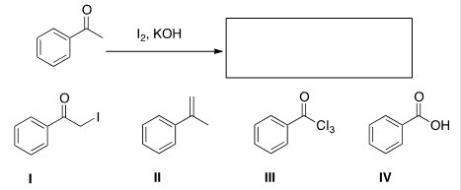
A)I
B)II
C)III
D)IV

A)I
B)II
C)III
D)IV
IV
3
Will acetophenone be completely deprotonated by lithium diisopropylamide (LDA)?
A)Yes
B)No
A)Yes
B)No
Yes
4
Which is the kinetic enolate of 2-methylcyclohexanone? 
A)I
B)II
C)III
D)IV

A)I
B)II
C)III
D)IV

Unlock Deck
Unlock for access to all 47 flashcards in this deck.
Unlock Deck
k this deck
5
Why is the enolate of acetone less basic than the allyl anion derived from propene?
A)Because there are more atoms in acetone
B)Because there are more resonance structures for the enolate of acetone
C)It isn't; the allyl anion is less basic.
D)One of the resonance structures for the enolate places the negative charge on the more electronegative oxygen.
A)Because there are more atoms in acetone
B)Because there are more resonance structures for the enolate of acetone
C)It isn't; the allyl anion is less basic.
D)One of the resonance structures for the enolate places the negative charge on the more electronegative oxygen.

Unlock Deck
Unlock for access to all 47 flashcards in this deck.
Unlock Deck
k this deck
6
Starting with cyclohexanone,how could you prepare the diketone below? 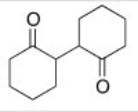
A)Treat cyclohexanone with a base under thermodynamic conditions.
B)Hydrogenate cyclohexanone with Raney nickel.
C)Convert cyclohexanone into the a-bromoketone and then react this with the enolate of cyclohexanone.
D)Convert cyclohexanone into an enamine with diethylamine and then react this with more cyclohexanone.

A)Treat cyclohexanone with a base under thermodynamic conditions.
B)Hydrogenate cyclohexanone with Raney nickel.
C)Convert cyclohexanone into the a-bromoketone and then react this with the enolate of cyclohexanone.
D)Convert cyclohexanone into an enamine with diethylamine and then react this with more cyclohexanone.

Unlock Deck
Unlock for access to all 47 flashcards in this deck.
Unlock Deck
k this deck
7
Will acetone be completely deprotonated by potassium tert-butoxide?
A)Yes
B)No
A)Yes
B)No

Unlock Deck
Unlock for access to all 47 flashcards in this deck.
Unlock Deck
k this deck
8
If you want to form a kinetic enolate,you want to
A)use a strong,non-nucleophilic base such as LDA.
B)use a protic solvent.
C)use a low temperature.
D)both use a strong,non-nucleophilic base such as LDA and use a low temperature.
A)use a strong,non-nucleophilic base such as LDA.
B)use a protic solvent.
C)use a low temperature.
D)both use a strong,non-nucleophilic base such as LDA and use a low temperature.

Unlock Deck
Unlock for access to all 47 flashcards in this deck.
Unlock Deck
k this deck
9
What is (are)the product(s)of the following reaction? 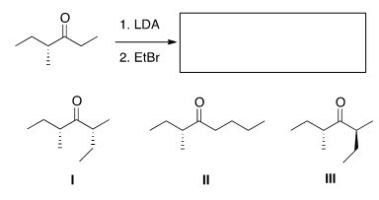
A)Only I
B)Only II
C)Only III
D)Only I and III

A)Only I
B)Only II
C)Only III
D)Only I and III

Unlock Deck
Unlock for access to all 47 flashcards in this deck.
Unlock Deck
k this deck
10
Which of the following is an enol form of the following compound? 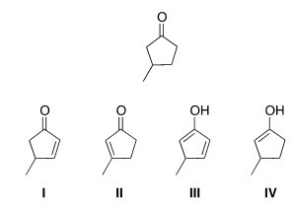
A)I
B)II
C)III
D)IV

A)I
B)II
C)III
D)IV

Unlock Deck
Unlock for access to all 47 flashcards in this deck.
Unlock Deck
k this deck
11
What are the three steps in the malonic ester synthesis?
A)Deprotonation,alkylation,hydrolysis/decarboxylation
B)Hydrogenation,alkylation,deprotonation
C)Alkylation,hydrolysis/decarboxylation.hydrogenation
D)Hydrolysis/decarboxylation,deprotonation,alkylation
A)Deprotonation,alkylation,hydrolysis/decarboxylation
B)Hydrogenation,alkylation,deprotonation
C)Alkylation,hydrolysis/decarboxylation.hydrogenation
D)Hydrolysis/decarboxylation,deprotonation,alkylation

Unlock Deck
Unlock for access to all 47 flashcards in this deck.
Unlock Deck
k this deck
12
If you want to form a thermodynamic enolate,you want to
A)keep the reaction as cold as possible.
B)use an aprotic solvent such as THF.
C)use a protic solvent such as ethanol.
D)use a carboxylic acid.
A)keep the reaction as cold as possible.
B)use an aprotic solvent such as THF.
C)use a protic solvent such as ethanol.
D)use a carboxylic acid.

Unlock Deck
Unlock for access to all 47 flashcards in this deck.
Unlock Deck
k this deck
13
Which is the most stable form of 1,3-cyclohexanedione? 
A)I
B)II
C)III
D)IV

A)I
B)II
C)III
D)IV

Unlock Deck
Unlock for access to all 47 flashcards in this deck.
Unlock Deck
k this deck
14
What is the missing reagent for the following reaction? 
A)Br2/HOAc
B)Br2/KOH
C)Cl2/FeCl3
D)Br2/FeBr3

A)Br2/HOAc
B)Br2/KOH
C)Cl2/FeCl3
D)Br2/FeBr3

Unlock Deck
Unlock for access to all 47 flashcards in this deck.
Unlock Deck
k this deck
15
Why is it difficult to stop the halogenation of ketones under basic conditions at the mono-halogenated stage?
A)The ketone undergoes a Bayer-Villigar oxidation.
B)The ketone is reduced.
C)The ketone undergoes an Aldol reaction.
D)The bromine helps to stabilize the second enolate,making the product more acidic than the starting material.
A)The ketone undergoes a Bayer-Villigar oxidation.
B)The ketone is reduced.
C)The ketone undergoes an Aldol reaction.
D)The bromine helps to stabilize the second enolate,making the product more acidic than the starting material.

Unlock Deck
Unlock for access to all 47 flashcards in this deck.
Unlock Deck
k this deck
16
What is the missing reagent in the reaction below? 
A)Br2/AcOH
B)I2/KOH
C)I2
D)KOH

A)Br2/AcOH
B)I2/KOH
C)I2
D)KOH

Unlock Deck
Unlock for access to all 47 flashcards in this deck.
Unlock Deck
k this deck
17
Why can't you prepare 2-tert-butylcyclohexanone by the following reaction? 
A)Because tert-butyl bromide is too basic.
B)Because tert-butyl bromide cannot undergo an SN2 reaction.
C)Because tert-butyl bromide is a nucleophile.
D)Because tert-butyl bromide is not a stable compound.

A)Because tert-butyl bromide is too basic.
B)Because tert-butyl bromide cannot undergo an SN2 reaction.
C)Because tert-butyl bromide is a nucleophile.
D)Because tert-butyl bromide is not a stable compound.

Unlock Deck
Unlock for access to all 47 flashcards in this deck.
Unlock Deck
k this deck
18
What is the product of the following reaction? 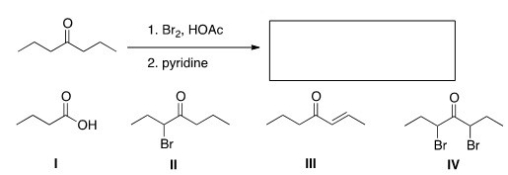
A)I
B)II
C)III
D)IV

A)I
B)II
C)III
D)IV

Unlock Deck
Unlock for access to all 47 flashcards in this deck.
Unlock Deck
k this deck
19
Which is the more stable form of acetophenone? 
A)Only I
B)Only II
C)Only III
D)I and II are equally stable

A)Only I
B)Only II
C)Only III
D)I and II are equally stable

Unlock Deck
Unlock for access to all 47 flashcards in this deck.
Unlock Deck
k this deck
20
Which of the following four compounds is the most acidic? 
A)I
B)II
C)III
D)IV

A)I
B)II
C)III
D)IV

Unlock Deck
Unlock for access to all 47 flashcards in this deck.
Unlock Deck
k this deck
21
For most compounds with a single keto group in the molecule,equilibrium favors the keto form over the enol form of the compound.This is due largely to what?
A)The C=O bond is much stronger than the C=C bond.
B)The C=C bond is much stronger than the C=O bond.
C)The keto form can undergo intramolecular hydrogen bonding.
D)The enol form can undergo intramolecular hydrogen bonding.
A)The C=O bond is much stronger than the C=C bond.
B)The C=C bond is much stronger than the C=O bond.
C)The keto form can undergo intramolecular hydrogen bonding.
D)The enol form can undergo intramolecular hydrogen bonding.

Unlock Deck
Unlock for access to all 47 flashcards in this deck.
Unlock Deck
k this deck
22
What is the starting material in the following reaction? 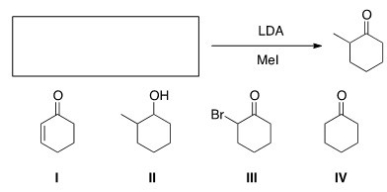
A)I
B)II
C)III
D)IV

A)I
B)II
C)III
D)IV

Unlock Deck
Unlock for access to all 47 flashcards in this deck.
Unlock Deck
k this deck
23
Which of the following compounds is an enol of compound X drawn below? 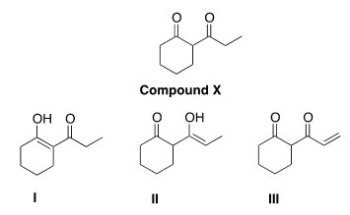
A)Only I
B)Only II
C)Only III
D)Only I and II

A)Only I
B)Only II
C)Only III
D)Only I and II

Unlock Deck
Unlock for access to all 47 flashcards in this deck.
Unlock Deck
k this deck
24
Which of the following bases will completely convert 1,4-cyclohexandione into an enolate?
A)Sodium hydroxide
B)Sodium methoxide
C)Sodium tert-butoxide
D)Sodium hydride
A)Sodium hydroxide
B)Sodium methoxide
C)Sodium tert-butoxide
D)Sodium hydride

Unlock Deck
Unlock for access to all 47 flashcards in this deck.
Unlock Deck
k this deck
25
The following molecule is called 
A)a 1,3-diketopentanoate.
B)a diethyl malonate.
C)an ethyl acetoacetate.
D)a b-keto ester.

A)a 1,3-diketopentanoate.
B)a diethyl malonate.
C)an ethyl acetoacetate.
D)a b-keto ester.

Unlock Deck
Unlock for access to all 47 flashcards in this deck.
Unlock Deck
k this deck
26
A simple chemical test to distinguish between acetone and 3-pentanone would be the reaction of the compounds with
A)bromine with acetic acid.
B)bromine and aqueous hydroxide ion.
C)THF,LDA at -78 °C followed by reaction with bromine.
D)base and methyl bromide.
A)bromine with acetic acid.
B)bromine and aqueous hydroxide ion.
C)THF,LDA at -78 °C followed by reaction with bromine.
D)base and methyl bromide.

Unlock Deck
Unlock for access to all 47 flashcards in this deck.
Unlock Deck
k this deck
27
It has been found that b-dicarbonyl compounds have a greater concentration of the enol form over the keto form.This can be explained by
A)the C=C of the enol is conjugated with the carbonyl group.
B)the -OH of the enol can hydrogen bond to the oxygen of the nearby carbonyl group.
C)Both and above are true.
D)None of the choices are true.
A)the C=C of the enol is conjugated with the carbonyl group.
B)the -OH of the enol can hydrogen bond to the oxygen of the nearby carbonyl group.
C)Both and above are true.
D)None of the choices are true.

Unlock Deck
Unlock for access to all 47 flashcards in this deck.
Unlock Deck
k this deck
28
Treatment of 2-hexanone with NaOCH2CH3 followed by CH3Br affords compound X (C7H14O)as the major product.X shows a strong absorption in the IR spectrum at 1713 cm-1,and its 1H NMR data is given below.What is the structure of X? 


A)I
B)II
C)III
D)IV



A)I
B)II
C)III
D)IV

Unlock Deck
Unlock for access to all 47 flashcards in this deck.
Unlock Deck
k this deck
29
Which of the following are enol forms of ethyl acetoacetate drawn below? 
A)Only I
B)Only II
C)Only III
D)I,II,and III

A)Only I
B)Only II
C)Only III
D)I,II,and III

Unlock Deck
Unlock for access to all 47 flashcards in this deck.
Unlock Deck
k this deck
30
What is the starting material for the following reaction? 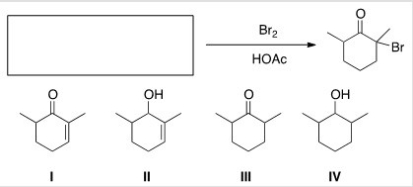
A)I
B)II
C)III
D)IV

A)I
B)II
C)III
D)IV

Unlock Deck
Unlock for access to all 47 flashcards in this deck.
Unlock Deck
k this deck
31
Which of the following compounds is the most acidic?
A)Ethyl acetoacetate
B)2-Butanone
C)1-Butanol
D)3-Pentanone
A)Ethyl acetoacetate
B)2-Butanone
C)1-Butanol
D)3-Pentanone

Unlock Deck
Unlock for access to all 47 flashcards in this deck.
Unlock Deck
k this deck
32
Which of the following ketones will give a positive iodoform test?
A)3-Heptanone
B)2-Pentanone
C)3-Hexanone
D)Cyclohexanone
A)3-Heptanone
B)2-Pentanone
C)3-Hexanone
D)Cyclohexanone

Unlock Deck
Unlock for access to all 47 flashcards in this deck.
Unlock Deck
k this deck
33
The malonic ester synthesis can be adapted to synthesize a-amino acids by using diethyl acetamidomalonate as the starting material.Select the structure of the amino acid produced by the following synthesis. 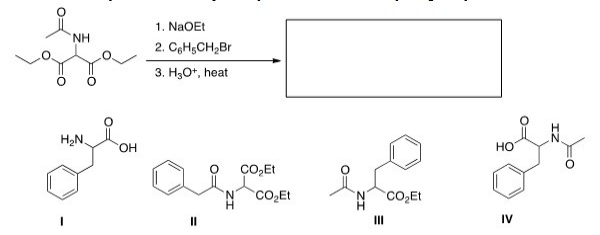
A)I
B)II
C)III
D)IV

A)I
B)II
C)III
D)IV

Unlock Deck
Unlock for access to all 47 flashcards in this deck.
Unlock Deck
k this deck
34
Which is the most acidic proton in the following compound? 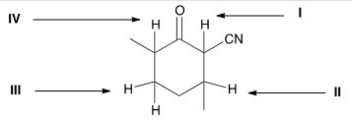
A)I
B)II
C)III
D)IV

A)I
B)II
C)III
D)IV

Unlock Deck
Unlock for access to all 47 flashcards in this deck.
Unlock Deck
k this deck
35
What is the major product of the following reaction? 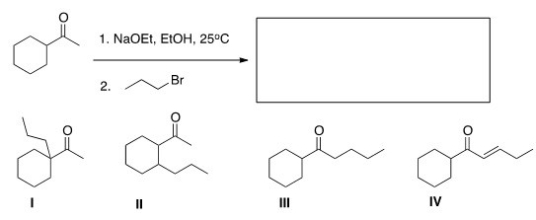
A)I
B)II
C)III
D)IV

A)I
B)II
C)III
D)IV

Unlock Deck
Unlock for access to all 47 flashcards in this deck.
Unlock Deck
k this deck
36
Which is the most acidic proton in the following compound? 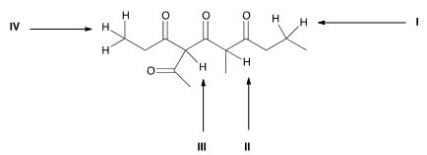
A)I
B)II
C)III
D)IV

A)I
B)II
C)III
D)IV

Unlock Deck
Unlock for access to all 47 flashcards in this deck.
Unlock Deck
k this deck
37
The reaction below is a direct enolate alkylation.It has been found that this reaction only works well with unhindered methyl and 1° alkyl halides.Pick the statement that best explains this observation. 
A)The nucleophilic enolate requires a reaction center that has a positive charge.
B)Hindered alkyl halides do not undergo SN1 reactions.
C)Hindered alkyl halides do not undergo SN2 reactions.
D)Methyl and 1° alkyl halides can form carbocations that can readily react with the nucleophilic enolate.

A)The nucleophilic enolate requires a reaction center that has a positive charge.
B)Hindered alkyl halides do not undergo SN1 reactions.
C)Hindered alkyl halides do not undergo SN2 reactions.
D)Methyl and 1° alkyl halides can form carbocations that can readily react with the nucleophilic enolate.

Unlock Deck
Unlock for access to all 47 flashcards in this deck.
Unlock Deck
k this deck
38
Which is the thermodynamic enolate of 2-methylcyclohexanone? 
A)I
B)II
C)III
D)IV

A)I
B)II
C)III
D)IV

Unlock Deck
Unlock for access to all 47 flashcards in this deck.
Unlock Deck
k this deck
39
Which of the following compounds would undergo racemization in the presence of a base? 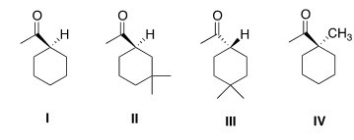
A)I
B)II
C)III
D)IV

A)I
B)II
C)III
D)IV

Unlock Deck
Unlock for access to all 47 flashcards in this deck.
Unlock Deck
k this deck
40
Select the appropriate sequence of reactions to accomplish the following synthesis. ![<strong>Select the appropriate sequence of reactions to accomplish the following synthesis. </strong> A)[1] Br<sub>2</sub>,CH<sub>3</sub>CO<sub>2</sub>H; [2] Li<sub>2</sub>CO<sub>3</sub>,LiBr,DMF; [3] CH<sub>3</sub>CH<sub>2</sub>CH<sub>2</sub>CH<sub>2</sub>Br B)[1] Br<sub>2</sub>,CH<sub>3</sub>CO<sub>2</sub>H; [2] Mg,Et<sub>2</sub>O; [3] CH<sub>3</sub>CH<sub>2</sub>CH<sub>2</sub>CH<sub>2</sub>Br C)[1] LDA; [2] BrCH<sub>2</sub>CH<sub>2</sub>CH<sub>2</sub>CH<sub>2</sub>Br; [3] NaOEt D)[1] NaOEt; [2] BrCH<sub>2</sub>CH<sub>2</sub>CH<sub>2</sub>CH<sub>2</sub>Br; [3] LDA](https://d2lvgg3v3hfg70.cloudfront.net/TB7662/11eac43c_f79c_51cc_a9af_db7270e325f4_TB7662_00.jpg)
A)[1] Br2,CH3CO2H; [2] Li2CO3,LiBr,DMF; [3] CH3CH2CH2CH2Br
B)[1] Br2,CH3CO2H; [2] Mg,Et2O; [3] CH3CH2CH2CH2Br
C)[1] LDA; [2] BrCH2CH2CH2CH2Br; [3] NaOEt
D)[1] NaOEt; [2] BrCH2CH2CH2CH2Br; [3] LDA
![<strong>Select the appropriate sequence of reactions to accomplish the following synthesis. </strong> A)[1] Br<sub>2</sub>,CH<sub>3</sub>CO<sub>2</sub>H; [2] Li<sub>2</sub>CO<sub>3</sub>,LiBr,DMF; [3] CH<sub>3</sub>CH<sub>2</sub>CH<sub>2</sub>CH<sub>2</sub>Br B)[1] Br<sub>2</sub>,CH<sub>3</sub>CO<sub>2</sub>H; [2] Mg,Et<sub>2</sub>O; [3] CH<sub>3</sub>CH<sub>2</sub>CH<sub>2</sub>CH<sub>2</sub>Br C)[1] LDA; [2] BrCH<sub>2</sub>CH<sub>2</sub>CH<sub>2</sub>CH<sub>2</sub>Br; [3] NaOEt D)[1] NaOEt; [2] BrCH<sub>2</sub>CH<sub>2</sub>CH<sub>2</sub>CH<sub>2</sub>Br; [3] LDA](https://d2lvgg3v3hfg70.cloudfront.net/TB7662/11eac43c_f79c_51cc_a9af_db7270e325f4_TB7662_00.jpg)
A)[1] Br2,CH3CO2H; [2] Li2CO3,LiBr,DMF; [3] CH3CH2CH2CH2Br
B)[1] Br2,CH3CO2H; [2] Mg,Et2O; [3] CH3CH2CH2CH2Br
C)[1] LDA; [2] BrCH2CH2CH2CH2Br; [3] NaOEt
D)[1] NaOEt; [2] BrCH2CH2CH2CH2Br; [3] LDA

Unlock Deck
Unlock for access to all 47 flashcards in this deck.
Unlock Deck
k this deck
41
What is the starting material required to accomplish the following transformation? 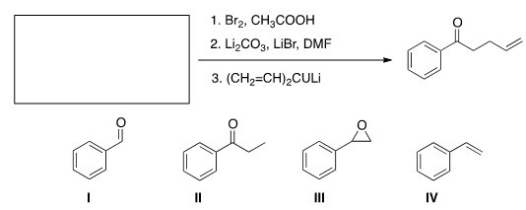
A)I
B)II
C)III
D)IV

A)I
B)II
C)III
D)IV

Unlock Deck
Unlock for access to all 47 flashcards in this deck.
Unlock Deck
k this deck
42
Which of the following is the least acidic compound? 
A)I
B)II
C)III
D)IV

A)I
B)II
C)III
D)IV

Unlock Deck
Unlock for access to all 47 flashcards in this deck.
Unlock Deck
k this deck
43
What is the structure of X,product of the following reaction? 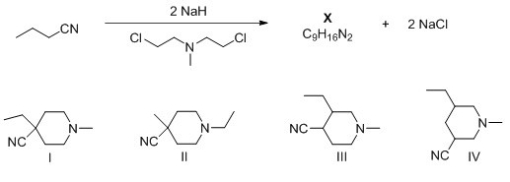
A)I
B)II
C)III
D)IV

A)I
B)II
C)III
D)IV

Unlock Deck
Unlock for access to all 47 flashcards in this deck.
Unlock Deck
k this deck
44
Which of the following would undergo racemization under basic conditions? 
A)I
B)II
C)III
D)IV

A)I
B)II
C)III
D)IV

Unlock Deck
Unlock for access to all 47 flashcards in this deck.
Unlock Deck
k this deck
45
Which of the following is a possible enol form of 2-butanone? 
A)I
B)II
C)III
D)II and III

A)I
B)II
C)III
D)II and III

Unlock Deck
Unlock for access to all 47 flashcards in this deck.
Unlock Deck
k this deck
46
Vitamin C is a stable enediol.Which is the structure of a possible keto form in equilibrium with the enediol form? 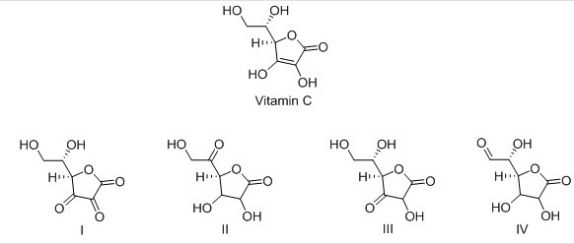
A)I
B)II
C)III
D)IV

A)I
B)II
C)III
D)IV

Unlock Deck
Unlock for access to all 47 flashcards in this deck.
Unlock Deck
k this deck
47
Which of the following is the most acidic compound? 
A)I
B)II
C)III
D)IV

A)I
B)II
C)III
D)IV

Unlock Deck
Unlock for access to all 47 flashcards in this deck.
Unlock Deck
k this deck



